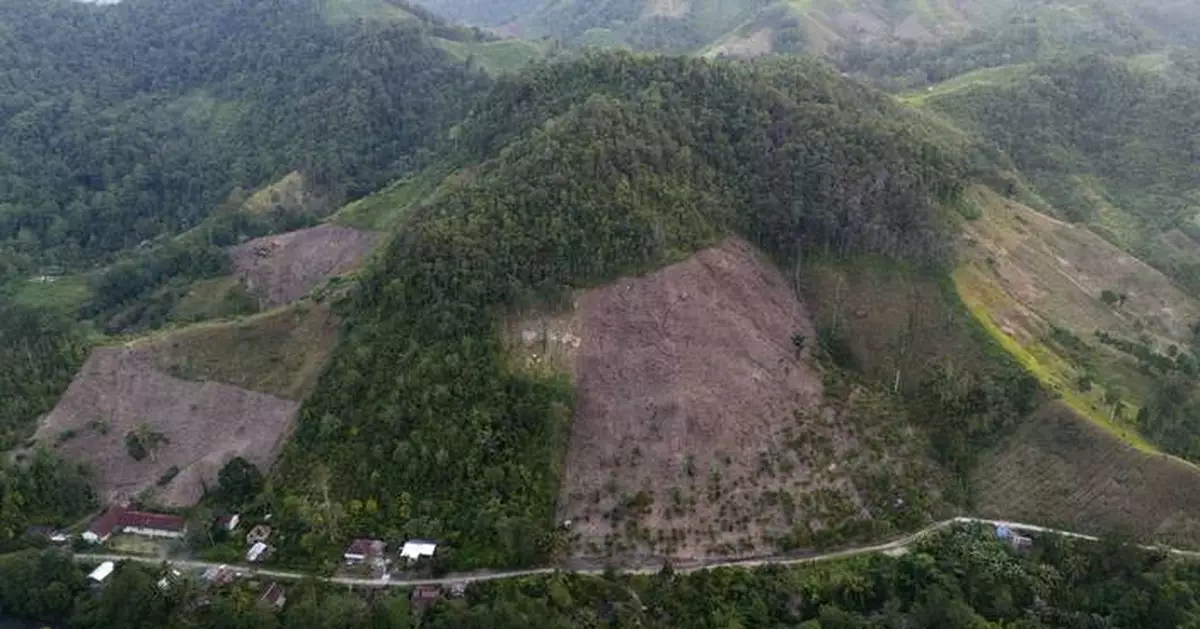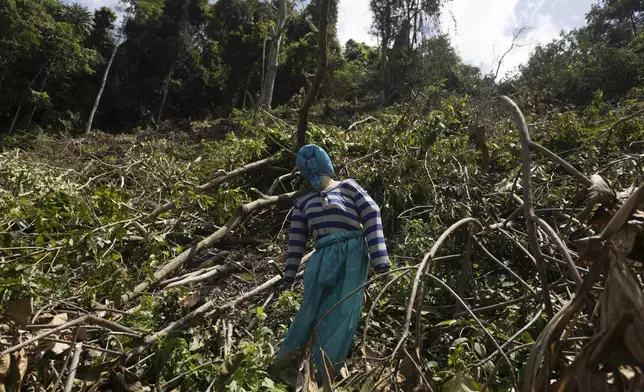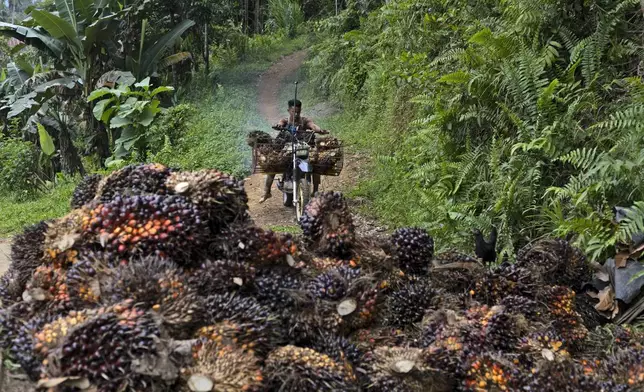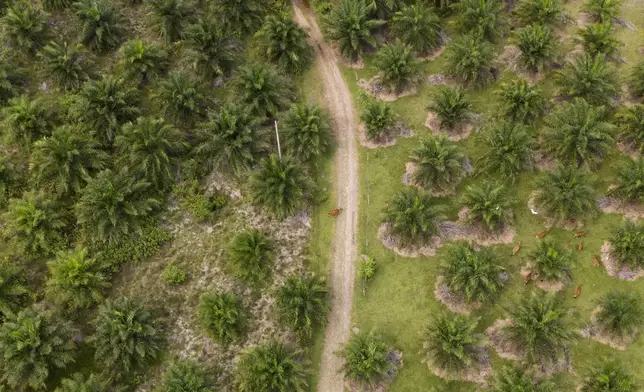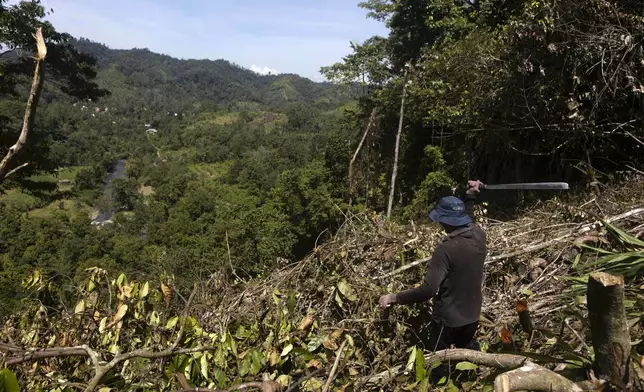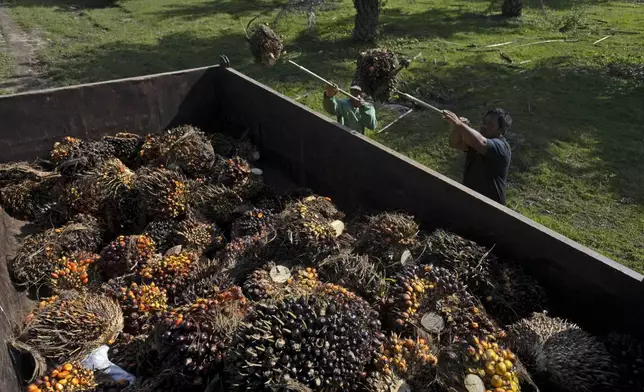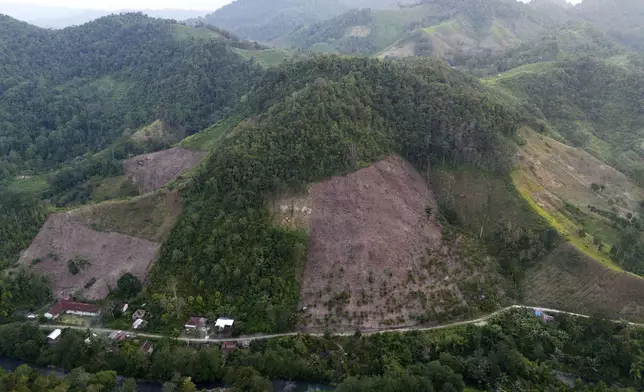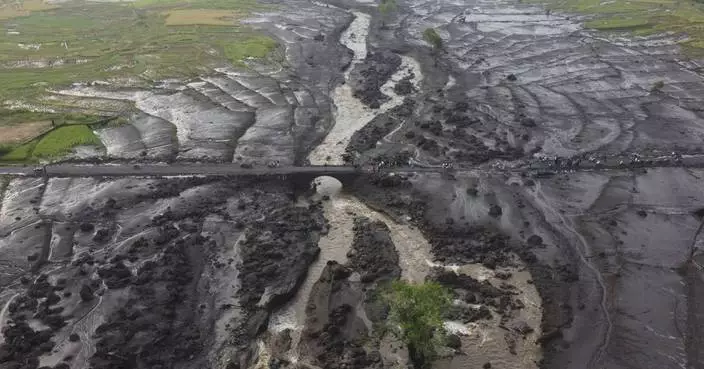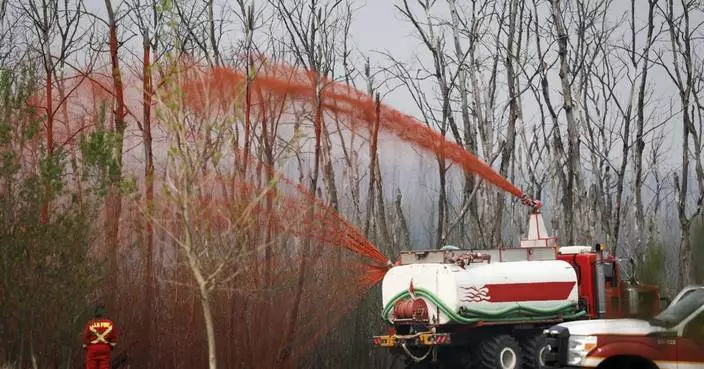JAKARTA, Indonesia (AP) — From trees felled in protected national parks to massive swaths of jungle razed for palm oil and paper plantations, Indonesia had a 27% uptick in primary forest loss in 2023 from the previous year, according to a World Resources Institute analysis of deforestation data. But the loss is still seen as historically low compared to the 2010s, it said.
“Deforestation has been declining from six or so years ago, when there were peak rates,” said Rod Taylor, global director of the forests program at WRI. “It's good news and commendable for Indonesia.”
Click to Gallery
JAKARTA, Indonesia (AP) — From trees felled in protected national parks to massive swaths of jungle razed for palm oil and paper plantations, Indonesia had a 27% uptick in primary forest loss in 2023 from the previous year, according to a World Resources Institute analysis of deforestation data. But the loss is still seen as historically low compared to the 2010s, it said.
A swath of forest on a hill that has been cleared from trees to make way for a corn plantation is visible in Polewali Mandar, South Sulawesi, Indonesia, Saturday, April 20, 2024. From trees felled in protected national parks to massive swaths of jungle razed for palm oil and paper plantations, Indonesia had a 27% uptick in primary forest loss in 2023 from the previous year, according to a World Resources Institute analysis of new deforestation data. (AP Photo/Yusuf Wahil)
A stump of a tree is visible at a swath of land that has been cleared to make way for a corn plantation Mandar, South Sulawesi, Indonesia, Sunday, April 21, 2024. From trees felled in protected national parks to massive swaths of jungle razed for palm oil and paper plantations, Indonesia had a 27% uptick in primary forest loss in 2023 from the previous year, according to a World Resources Institute analysis of new deforestation data. (AP Photo/Yusuf Wahil)
A man uses a motorcycle to transport palm fruit at a plantation in Polewali Mandar, South Sulawesi, Indonesia, Sunday, April 21, 2024. Indonesia saw a 27% increase in primary forest loss in 2023, according to an analysis of data shared by World Resources Institute. The tree losses came in protected national parks and in massive swaths of jungle cut down for palm oil and paper plantations and for mining. (AP Photo/Yusuf Wahil)
Cows graze at a palm oil plantation in Polewali Mandar, South Sulawesi, Indonesia, Tuesday, April 23, 2024. From trees felled in protected national parks to massive swaths of jungle razed for palm oil and paper plantations, Indonesia had a 27% uptick in primary forest loss in 2023 from the previous year, according to a World Resources Institute analysis of new deforestation data. (AP Photo/Yusuf Wahil)
A man uses a machete to clear land to make way for a corn plantation in Polewali Mandar, South Sulawesi, Indonesia, Sunday, April 21, 2024. From trees felled in protected national parks to massive swaths of jungle razed for palm oil and paper plantations, Indonesia had a 27% uptick in primary forest loss in 2023 from the previous year, according to a World Resources Institute analysis of new deforestation data. (AP Photo/Yusuf Wahil)
Men load palm fruit onto a truck at a palm oil plantation in Polewali Mandar, South Sulawesi, Indonesia, Tuesday, April 23, 2024. Indonesia saw a 27% increase in primary forest loss in 2023, according to an analysis of data shared by World Resources Institute. The tree losses came in protected national parks and in massive swaths of jungle cut down for palm oil and paper plantations and for mining. (AP Photo/Yusuf Wahil)
A hill that has been cleared from trees to make way for a corn plantation is visible in Polewali Mandar, South Sulawesi, Indonesia, Saturday, April 20, 2024. From trees felled in protected national parks to massive swaths of jungle razed for palm oil and paper plantations, Indonesia had a 27% uptick in primary forest loss in 2023 from the previous year, according to a World Resources Institute analysis of new deforestation data. (AP Photo/Yusuf Wahil)
But others saw cause for concern in the uptick, and tied some of the more recent deforestation to the world's appetite for mining Indonesia's vast deposits of nickel, which is critical for the green energy transition.
The latest data from the University of Maryland's Global Land Analysis and Discovery laboratory was shared on Global Forest Watch — a platform run by WRI that provides data, technology and tools for monitoring the world’s forests.
A vast tropical archipelago stretching across the equator, Indonesia is home to the world’s third-largest rainforest, with a variety of endangered wildlife and plants, including orangutans, elephants and giant forest flowers. Some live nowhere else.
Since 1950, more than 74 million hectares (285,715 square miles) of Indonesian rainforest — an area twice the size of Germany — have been logged, burned or degraded for development of palm oil, paper and rubber plantations, nickel mining and other commodities, according to Global Forest Watch. Indonesia is the biggest producer of palm oil, one of the largest exporters of coal and a top producer of pulp for paper. It also exports oil and gas, rubber, tin and other resources.
Expansion of industrial plantations occurred in several locations adjacent to existing palm oil tree and pulp and paper plantations on the tropical islands of Kalimantan and West Papua, according to the analysis.
The Indonesian Ministry of Environment and Forestry said the expansion occurred in concessions granted before the current administration took office in 2014.
The Indonesian Ministry of Environment and Forestry did not respond to questions and a request for comment sent by The Associated Press.
Global Forest Watch’s data on Indonesia's loss of primary forests — which are old-growth forests typically high in stored carbon and rich in biodiversity — are higher than the official Indonesian statistics. That’s because much of the primary forest loss in Indonesia, according to the analysis, is within areas that Indonesia classifies as secondary forest — areas that have regenerated through largely natural processes after human actions such as agriculture clearing or timber harvest. Secondary forests typically have reduced capacity for storing carbon than primary forests.
Deforestation linked to the mining industry occurred in Sumatra, Sulawesi, Mlauku and Kalimantan, according to the analysis.
Indonesia has the world’s largest reserves of nickel — a critical material for electric vehicles, solar panels and other goods needed for the green energy transition. And part of this deforestation can be directly linked to the expansion of Indonesia's nickel industry, said Timer Manurung, director of Auriga Nusantara, a nongovernmental conservation organization based in Indonesia.
Manurung said it's not clear exactly how much of Indonesia deforestation is due to mining. But he called it a “significant driver,” and said the government's rapid development of the country's mining and nickel industry — including more than 20 new smelters to process the nickel ore — is “repeating Indonesia's oil palm and pulpwood mistakes” of increasing deforestation.
But Taylor noted that deforestation done on a massive scale seems to be shrinking, compared to the past.
In the 2010s there was gargantuan oil palm, timber and large-scale plantation expansion across Indonesia. Research in the Nature Climate Change journal found that the deforestation rate doubled to approximately 2 million hectares per year during 2004-2014.
In 2023, primary forest loss in patches greater than 100 hectares made up just 15% of the loss, according to the analysis.
Taylor attributes this lack of large-scale deforestation patches to the reputational risks that companies face if they are found to be razing trees. In recent decades nongovernmental organizations, consumers and governments — including the European Union — have pushed for companies to move away from deforestation practices.
In 2018 Indonesian President Joko Widodo put a three-year freeze on new permits for palm oil plantations. And the rate of deforestation slowed between 2021-2022, according to government data.
But small-scale primary forest loss was still prevalent throughout the country, including within several protected areas such as Tesso Nilo National Park and Rawa Singkil Wildlife Reserve on the island of Sumatra. Both areas are home to critically endangered animals such as tigers and elephants.
A wetter than usual El Nino — which usually leads to less rainfall and higher temperatures that can cause rapid spread of fires set to clear land for agriculture — contributed to a quieter than expected fire season, Taylor said. So did investments made by the Indonesian government in fire prevention capabilities, as well as efforts to suppress fire by local communities.
During Indonesia's last El Nino in 2015-2016, fires intentionally started to clear land for agriculture rapidly spread, sending haze across Southeast Asia. Several Indonesian provinces declared states of emergencies, respiratory illnesses spiked and thousands of Indonesians had to flee their homes.
“The good news in Indonesia is that the fire prevention measures are much more sophisticated than they were in years past,” said Taylor. “It’s really making a difference.”

A dummy is erected on a swath of land that has been cleared to make way for a corn plantation in Polewali Mandar, South Sulawesi, Indonesia, Sunday, April 21, 2024. From trees felled in protected national parks to massive swaths of jungle razed for palm oil and paper plantations, Indonesia had a 27% uptick in primary forest loss in 2023 from the previous year, according to a World Resources Institute analysis of new deforestation data. (AP Photo/Yusuf Wahil)

A swath of forest on a hill that has been cleared from trees to make way for a corn plantation is visible in Polewali Mandar, South Sulawesi, Indonesia, Saturday, April 20, 2024. From trees felled in protected national parks to massive swaths of jungle razed for palm oil and paper plantations, Indonesia had a 27% uptick in primary forest loss in 2023 from the previous year, according to a World Resources Institute analysis of new deforestation data. (AP Photo/Yusuf Wahil)

A stump of a tree is visible at a swath of land that has been cleared to make way for a corn plantation Mandar, South Sulawesi, Indonesia, Sunday, April 21, 2024. From trees felled in protected national parks to massive swaths of jungle razed for palm oil and paper plantations, Indonesia had a 27% uptick in primary forest loss in 2023 from the previous year, according to a World Resources Institute analysis of new deforestation data. (AP Photo/Yusuf Wahil)

A man uses a motorcycle to transport palm fruit at a plantation in Polewali Mandar, South Sulawesi, Indonesia, Sunday, April 21, 2024. Indonesia saw a 27% increase in primary forest loss in 2023, according to an analysis of data shared by World Resources Institute. The tree losses came in protected national parks and in massive swaths of jungle cut down for palm oil and paper plantations and for mining. (AP Photo/Yusuf Wahil)

Cows graze at a palm oil plantation in Polewali Mandar, South Sulawesi, Indonesia, Tuesday, April 23, 2024. From trees felled in protected national parks to massive swaths of jungle razed for palm oil and paper plantations, Indonesia had a 27% uptick in primary forest loss in 2023 from the previous year, according to a World Resources Institute analysis of new deforestation data. (AP Photo/Yusuf Wahil)

A man uses a machete to clear land to make way for a corn plantation in Polewali Mandar, South Sulawesi, Indonesia, Sunday, April 21, 2024. From trees felled in protected national parks to massive swaths of jungle razed for palm oil and paper plantations, Indonesia had a 27% uptick in primary forest loss in 2023 from the previous year, according to a World Resources Institute analysis of new deforestation data. (AP Photo/Yusuf Wahil)

Men load palm fruit onto a truck at a palm oil plantation in Polewali Mandar, South Sulawesi, Indonesia, Tuesday, April 23, 2024. Indonesia saw a 27% increase in primary forest loss in 2023, according to an analysis of data shared by World Resources Institute. The tree losses came in protected national parks and in massive swaths of jungle cut down for palm oil and paper plantations and for mining. (AP Photo/Yusuf Wahil)

A hill that has been cleared from trees to make way for a corn plantation is visible in Polewali Mandar, South Sulawesi, Indonesia, Saturday, April 20, 2024. From trees felled in protected national parks to massive swaths of jungle razed for palm oil and paper plantations, Indonesia had a 27% uptick in primary forest loss in 2023 from the previous year, according to a World Resources Institute analysis of new deforestation data. (AP Photo/Yusuf Wahil)
MEXICO CITY (AP) — Newly minted Michelin-starred chef Arturo Rivera Martínez stood over an insanely hot grill Wednesday at the first Mexican taco stand ever to get a coveted star from the French dining guide, and did exactly the same thing he's been doing for 20 years: searing meat.
Though Michelin representatives came by Wednesday to present him with one of the company's heavy, full-sleeved, pristine white chef’s jackets, he didn't put it on: In this tiny, 10-foot by 10-foot (3-meter by 3-meter) business, the heat makes the meat. And the heat is intense.
At Mexico City’s Tacos El Califa de León, in the scruffy-bohemian San Rafael neighborhood, there are only four things on the menu, all tacos, and all of which came from some area around a cow’s rib, loin or fore shank.
“The secret is the simplicity of our taco. It has only a tortilla, red or green sauce, and that's it. That, and the quality of the meat,” said Rivera Martínez. He's also probably the only Michelin-starred chef who, when asked what beverage should accompany his food, answers “I like a Coke.”
It's actually more complicated than that. El Califa de León is the only taco stand among the 16 Mexican restaurants given one star, as well as two eateries that got two stars. Almost all the rest are pretty darn posh eateries (hint: a lot of expensive seafood served in pretty shells on bespoke plates).
In fact, other than perhaps one street food stand in Bangkok, El Califa de León is probably the smallest restaurant ever to get a Michelin star: Half of the 100 square-foot (9.29 square-meter) space is taken up by a solid steel plate grill that's hotter than the salsa.
The other half is packed with standing customers clutching plastic plates and ladling salsa, and the female assistant who rolls out the rounds of tortilla dough constantly.
In a way, El Califa de León is a tribute to resistance to change. It got there by doing exactly the same four things it has been doing since 1968.
Thousands of time a day, Rivera Martínez grabs a fresh, thinly sliced fillet of beef from a stack and slaps it on the super-hot steel grill; it sizzles violently.
He tosses a pinch of salt over it, squeezes half a lime on top, and grabs a soft round of freshly rolled tortilla dough onto the solid metal slab to puff up.
After less than a minute — he won’t say exactly how long because “that’s a secret” — he flips the beef over with a spatula, flips the tortilla, and very quickly scoops the cooked, fresh tortilla onto a plastic plate, places the beef on top and calls out the customer’s name who ordered it.
Any sauces — fiery red or equally atomic green — are added by the customer. There is no place to sit and at some times of day, no place to stand because the sidewalk in front of the business was taken over by street vendors hawking socks and batteries and cell phone accessories years ago.
Not that you really would want to eat inside the tiny taco restaurant. The heat on a spring day is overwhelming.
The heat is one of the few secrets Rivera Martínez would share. The steel grill has to be heated to an astounding 680 degrees (360 Celsius). Asked how it felt to get a Michelin star, he said in classic Mexico City slang, “está chido ... está padre,” or “it's neat, it's cool.”
The prices are quite high by Mexican standards. A single, generous but not huge taco costs nearly $5. But many customers are convinced it's the best, if not the cheapest, in the city.
“It's the quality of the meat,” said Alberto Muñoz, who has been coming here for about eight years. “I have never been disappointed. And now I'll recommend it with even more reason, now that it has a star.”
Muñoz's son, Alan, who was waiting for a beef taco alongside his father, noted “this is a historic day for Mexican cuisine, and we're witnesses to it.”
It really is about not changing anything — the freshness of the tortillas, the menu, the layout of the restaurant. Owner Mario Hernández Alonso won't even reveal where he buys his meat.
Times have changed, though. The most loyal customer base for El Califa de León originally came from politicians of the old ruling PRI party, whose headquarters is about five blocks away. But the party lost the presidency in 2018 and has gone into a steady decline, and now it's rare to see anyone in a suit here.
And Hernández Alonso noted that his father Juan, who founded the business, never bothered to trademark the Califa name and so a well-funded, sleek taco chain has opened about 15 airy restaurants in upscale neighborhoods under a similar name. Hernández Alonso has been toying with the idea of getting the business on social media, but that's up to his grandkids.
By law, following the coronavirus pandemic, Mexico City restaurants have been allowed to open up street-side canopied seating areas. But El Califa de León doesn’t even have a sidewalk for customers to eat on because of all the street vendors, so customers now stand cheek-to jowl with display stands and plastic mannequins.
Asked if he would like them to make room for a street-side seating area, Hernández Alonso expressed an “if it ain't broke, don't fix it” attitude.
“As the saying goes, why fix or change something that's alright? You shouldn't fix anything,” he said, motioning to the street vendors. “It's the way God ordered things, and you have to deal with it.”

A customer flashes a thumbs up while eating a taco from the Tacos El Califa de León taco stand, in Mexico City, Wednesday, May 15, 2024. Tacos El Califa de León is the first ever taco stand to receive a Michelin star from the French dining guide. (AP Photo/Fernando Llano)

An overhead view of the Tacos El Califa de León taco stand, in Mexico City, Wednesday, May 15, 2024. Tacos El Califa de León is the first ever taco stand to receive a Michelin star from the French dining guide. (AP Photo/Fernando Llano)

CORRECTS NAME - Mario Hernández Alonso, owner of Tacos El Califa de León, speaks with reporters in Mexico City, Wednesday, May 15, 2024. Tacos El Califa de León is the first ever taco stand to receive a Michelin star from the French dining guide. (AP Photo/Fernando Llano)

A customer finishes squeezing lime juice on his tacos at the Tacos El Califa de León stand, in Mexico City, Wednesday, May 15, 2024. Tacos El Califa de León is the first ever taco stand to receive a Michelin star from the French dining guide. (AP Photo/Fernando Llano)

Customers line up to order at the Tacos El Califa de León taco stand, in Mexico City, Wednesday, May 15, 2024. Tacos El Califa de León is the first ever taco stand to receive a Michelin star from the French dining guide. (AP Photo/Fernando Llano)

A customer holds his partially eaten taco at the Tacos El Califa de León taco stand, in Mexico City, Wednesday, May 15, 2024. Tacos El Califa de León is the first ever taco stand to receive a Michelin star from the French dining guide. (AP Photo/Fernando Llano)

Newly minted Michelin-starred chef Arturo Rivera Martínez prepares an order of tacos at the Tacos El Califa de León taco stand, in Mexico City, Wednesday, May 15, 2024. Tacos El Califa de León is the first ever taco stand to receive a Michelin star from the French dining guide. (AP Photo/Fernando Llano)

A worker warms corn tortillas on a griddle at the Tacos El Califa de León taco stand, in Mexico City, Wednesday, May 15, 2024. Tacos El Califa de León is the first ever taco stand to receive a Michelin star from the French dining guide. (AP Photo/Fernando Llano)

An employee tosses a tortilla on a griddle at the Tacos El Califa de León taco stand, in Mexico City, Wednesday, May 15, 2024. Tacos El Califa de León is the first ever taco stand to receive a Michelin star from the French dining guide. (AP Photo/Fernando Llano)

A worker hands a customer his order of tacos at the Tacos El Califa de León taco stand, in Mexico City, Wednesday, May 15, 2024. Tacos El Califa de León is the first ever taco stand to receive a Michelin star from the French dining guide. (AP Photo/Fernando Llano)
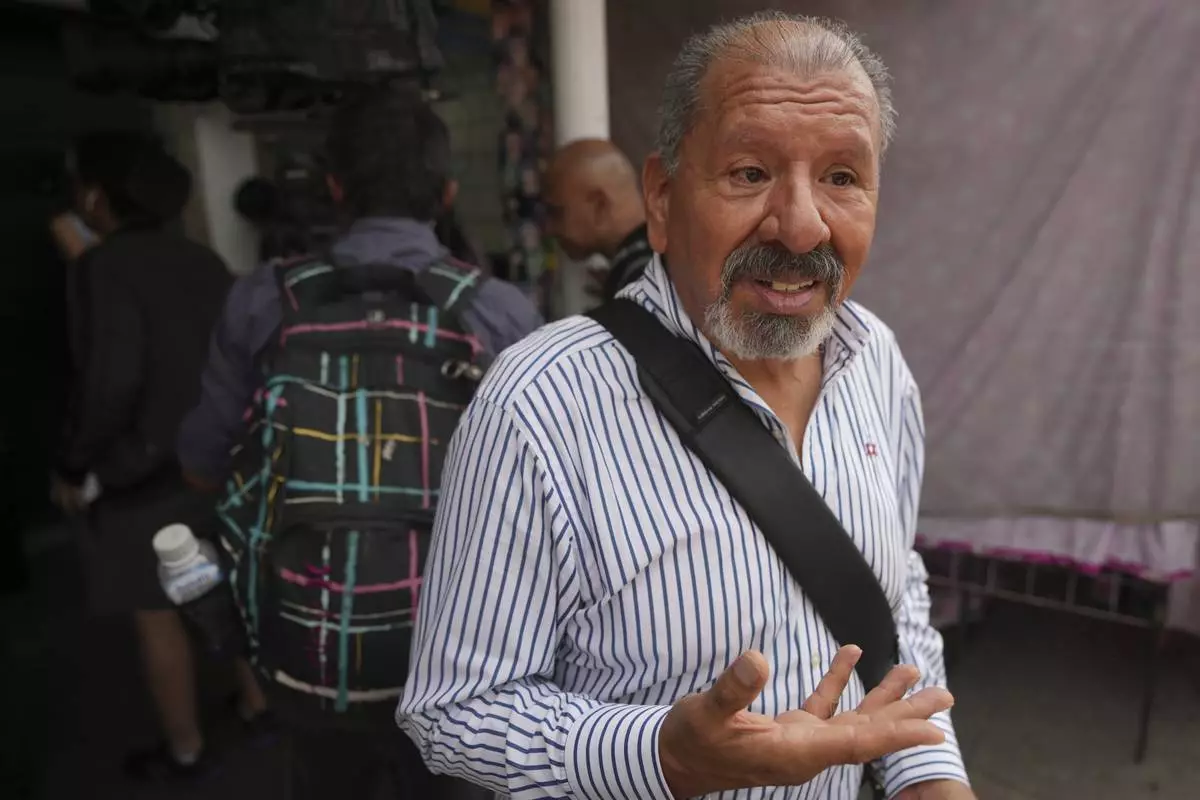
Mexican chef Arturo Rivera Martínez, owner of Tacos El Califa de León, speaks with reporters in Mexico City, Wednesday, May 15, 2024. Tacos El Califa de León is the first ever taco stand to receive a Michelin star from the French dining guide. (AP Photo/Fernando Llano)










